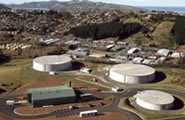Fit to Drink
Faced with new drinking-water standards that rated Dunedin's water as Ee, the lowest of the low, Dunedin City Council decided it had to replace one of its two main water treatment plants. Fiona Clarkson reports on the new plant, which incorporates New Zealand's first submerged-membrane water treatment process.
Dunedin City Council and project managers and civil works designers MWH New Zealand Ltd are justifiably proud of the Southern Water Treatment Plant. The use of a submerged membrane barrier against cryptosporidium and giardia spores was a first for New Zealand. And, after a lengthy lead-up, the project was completed on time, at 15 percent below budget, and was virtually problem-free from the first day of operation.
Eleven years ago, Dunedin conducted a major strategic review of its water treatment processes, after a change in drinking-water standards meant the city's water went from an A to Ee rating overnight (that's E for treatment and e for reticulation). The review concluded that a 12-year plan of capital works upgrades was needed to achieve an Ac grading, and the city's two main treatment plants, Mt Grand and Southern, would be the focus.
For the Mt Grand plant, constructed in 1977, the review recommended a reservoir to provide more raw water storage, and the addition of dissolved-air flotation and UV disinfection.
At the Southern plant, constructed in 1956 and upgraded in 1971, more drastic measures were needed. The plant only used chlorination and microstraining, leaving a bad taste in residents' mouths and frequently a murky colour in their glasses. It was decided to start again, using a greenfields site adjacent to the existing facility.
Roger Oakley MIPENZ, a senior civil engineer with MWH, says the project started with the broadest possible brief – little more than a timeframe and a budget – and the direction to construct a plant that would deliver A-grade water.
The project was undertaken in several stages. Work began in 2000 on building two 20,000m3 treated-water storage reservoirs (representing one to two days' usage) and pipe infrastructure to connect the still-bare site to existing networks.
At the same time, an 18-month-long pilot programme began testing submerged membranes as a possible treatment process. Two submerged membranes were tested, along with a traditional dual-media filter and a pressure membrane.
Finally, construction started on the treatment plant itself, using submerged membranes from Memcor Australia, traditional coagulation and flocculation processes, three UV reactors, and chemical dosing.
The multi-barrier plant started delivering water in July 2005, and now has a provisional A grade from the Ministry of Health.



